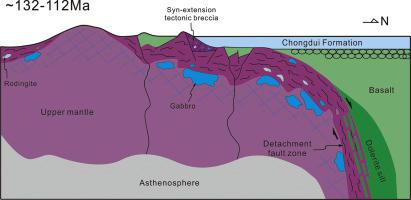Gondwana Research ( IF 7.2 ) Pub Date : 2021-02-20 , DOI: 10.1016/j.gr.2021.02.006 Y. Li , R.B. Li , P.T. Robinson , S.B. Yang , J. Zhang , J.S. Yang

|
The structure and lithological sequences of ophiolites provide critical information for reconstructing their tectonic setting and thus, the history of the paleo-oceanic basins in which they formed. Our systematic mapping of three of the best-preserved massifs in the Xigaze ophiolite from the middle segment of the Yarlung Zangbo Suture Zone (YZSZ) in South Tibet, revealed a nearly intact structure of the ophiolitic sequence that has largely escaped emplacement and post-emplacement dismemberment. One of the most important results is the identification of a nearly E-W striking, serpentinized shear zone (SPSZ) preserved within the sequence. The SPSZ is rooted in the serpentinized front of the upper mantle and is mainly composed of meta-gabbroic and rodingite lenses floating in a serpentinite matrix. Extensive talc-serpentinite metasomatism, shearing and cataclastic deformation in the SPSZ reveal a complex interplay of fluid metasomatism and progressive ductile-brittle deformation in hundreds of meters of shear zone between the mantle and the crust. The structural and petrological features of the SPSZ are very similar to those of detachment faults within modern in situ oceanic core complexes (OCCs) in the Mid-Atlantic Ridge and the Southwest Indian Ridge. Zircon U Pb ages from the footwall of the fault, and the age of radiolarian chert overlying it suggest that the detachment faulting took place between ca. 125 to 123 Ma. Combined with the stratigraphic and geochronological relationships between the ophiolite and the overlying sediments, we suggest that the Xigaze ophiolite developed in the supra-subduction zone on the southern margin of the Lhasa terrane during rollback of the Neo-Tethyan oceanic slab. Recognition of detachment faulting in the Xigaze ophiolites, along with other features, suggest that the Xigaze ophiolite formed at a spreading ridge, whereas the other large ultramafic massifs in YZSZ, may have formed in an off-axis location on the slow-spreading ridge.
Pb ages from the footwall of the fault, and the age of radiolarian chert overlying it suggest that the detachment faulting took place between ca. 125 to 123 Ma. Combined with the stratigraphic and geochronological relationships between the ophiolite and the overlying sediments, we suggest that the Xigaze ophiolite developed in the supra-subduction zone on the southern margin of the Lhasa terrane during rollback of the Neo-Tethyan oceanic slab. Recognition of detachment faulting in the Xigaze ophiolites, along with other features, suggest that the Xigaze ophiolite formed at a spreading ridge, whereas the other large ultramafic massifs in YZSZ, may have formed in an off-axis location on the slow-spreading ridge.











































 京公网安备 11010802027423号
京公网安备 11010802027423号